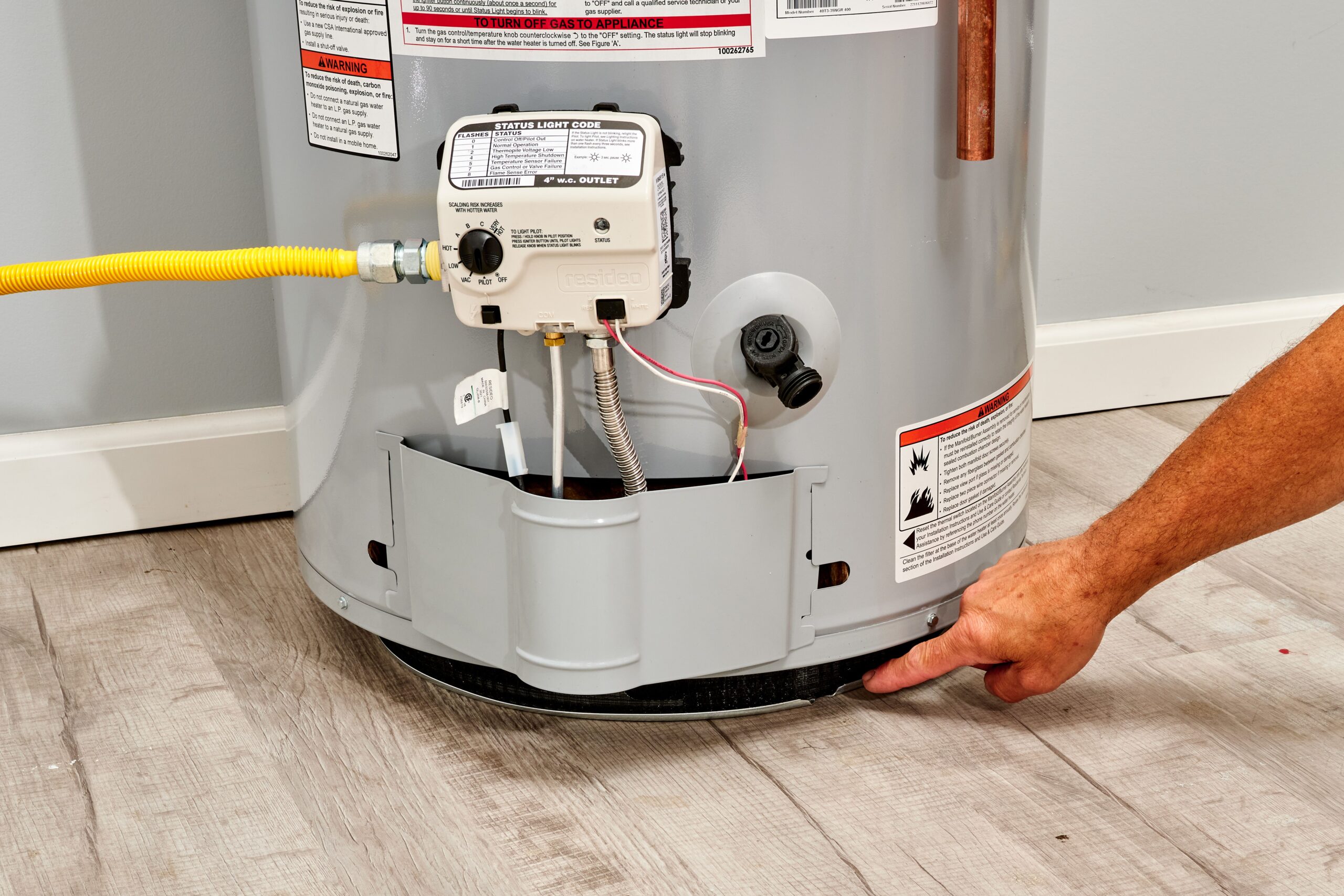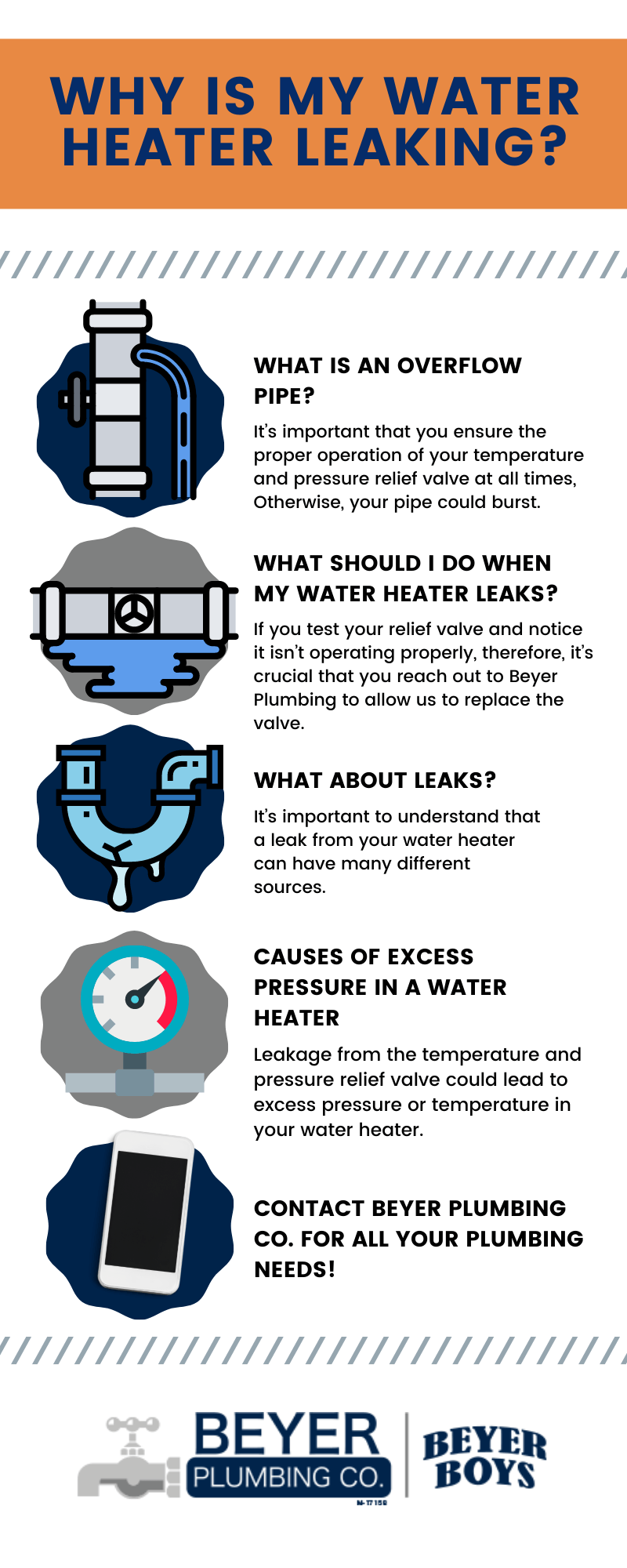If water is dripping from your overflow pipe, it likely means your T&P valve needs replacing. The T&P valve prevents high temperature or pressure issues in the tank.
Experiencing water dripping from the overflow pipe of your water heater can be a cause for concern. In most cases, this indicates a malfunction with the temperature and pressure relief valve (T&P valve), which is crucial for maintaining safe operation of the water heater.
Understanding the reasons behind this issue and knowing how to address it promptly can help prevent potential water damage and ensure the efficient functioning of your water heating system. Let’s delve into the common causes of water dripping from the overflow pipe of your water heater and explore solutions to rectify the problem effectively.

Common Causes Of Water Heater Dripping
If your water heater is dripping from the overflow pipe, it may indicate a faulty temperature and pressure relief valve. This valve releases excess water when the tank’s temperature or pressure is too high, serving as a crucial safety measure to prevent tank damage.
Adjusting the thermostat temperature can help resolve the issue.
Faulty Temperature And Pressure Relief Valve (t&p Valve)
If water is dripping from your water heater’s overflow pipe, a common culprit could be the T&P valve. This valve releases water when the temperature or pressure inside the tank gets too high.
Excessive Tank Pressure Or Temperature
Another reason for water heater dripping is excessive pressure or temperature within the tank. This can lead to the overflow pipe releasing water as a safety measure.
Cracked Water Heater Tank
A cracked tank can also cause water heater dripping. The cracks can result in water seepage, leading to leaks from the overflow pipe.

Credit: beyerplumbing.com
Signs Of Water Heater Leakage
Overflow Pipe Dripping
If you notice water dripping from the overflow pipe of your water heater, it indicates a potential problem with the temperature and pressure relief valve (T&P valve). The T&P valve serves as a critical safety feature, releasing water when the pressure or temperature exceeds safe levels for the tank. Addressing this issue promptly is essential to prevent further damage to your water heater and avoid potential safety hazards.
Water Coming From Drain Pipe
When water emerges from the drain pipe of your water heater, it may signal a failing water heater or a malfunctioning valve. Although the leak could appear slow, it should not be neglected as it has the potential to cause significant water damage to your property. In the event of the drain valve failing, all the water stored in the tank could flood the surrounding area, leading to costly repairs and inconveniences.
Pressure Relief Valve Dripping
A dripping pressure relief valve on your water heater might be an indication of excessive pressure or temperature within the tank. This could be due to a faulty valve or an overheating issue, potentially causing your water heater to malfunction or pose safety risks. Promptly inspect and address any signs of leakage from the pressure relief valve to ensure the continued efficiency and safety of your water heater.
Fixes For Water Heater Dripping Issues
If you’ve noticed water dripping from your water heater’s overflow pipe, it’s important to address the issue promptly to prevent any further damage. There are a few common fixes for water heater dripping problems that you can try.
Replacing The T&p Valve
One possible cause for water heater dripping is a malfunctioning temperature and pressure relief (T&P) valve. The T&P valve is a safety device that releases water if the temperature or pressure inside the tank becomes too high. Over time, these valves can wear out or become faulty, leading to water leaking from the overflow pipe.
To replace the T&P valve, follow these steps:
- Turn off the power supply to the water heater.
- Shut off the cold water supply to the tank.
- Attach a hose to the drain valve on the bottom of the tank and place the other end in a suitable drainage location.
- Drain the tank by opening the drain valve.
- Use a wrench to remove the old T&P valve.
- Wrap plumber’s tape around the threads of the new T&P valve.
- Install the new T&P valve and tighten it with a wrench.
- Turn on the cold water supply and allow the tank to fill.
- Open a hot water faucet in your home to purge any air from the tank.
- Once the tank is full, turn on the power supply to the water heater.
Lowering Tank Temperature
Another possible reason for water heater dripping is that the water temperature inside the tank is set too high. When the temperature exceeds the recommended limit, the T&P valve may open and release water from the overflow pipe.
To lower the tank temperature:
- Locate the thermostat on the water heater.
- Use a screwdriver to adjust the temperature setting to a lower level.
- Wait for a few hours for the water temperature to stabilize.
- Check if the water heater is still dripping. If not, the issue is resolved.
Repairing Or Replacing A Cracked Tank
If none of the previous fixes solve the water heater dripping problem, it could indicate a cracked tank. A cracked tank is a serious issue that requires immediate attention. In this case, it’s recommended to contact a professional plumber to assess the situation and determine if the tank needs to be repaired or replaced.
Don’t ignore water heater dripping issues, as they can lead to further damage and potential safety hazards. By following these fixes, you can address the problem and ensure your water heater operates efficiently and safely.
Preventative Maintenance To Avoid Dripping
To prevent water dripping from the overflow pipe of your water heater, regularly check and replace the temperature and pressure relief valve. This valve safeguards the tank by releasing excess water if pressure or temperature exceeds safe levels, ensuring efficient operation and safety of your water heater.
Regular Checking Of T&p Valve
Regularly checking the temperature and pressure relief valve (T&P valve) of your water heater is an important part of preventative maintenance to avoid dripping. The T&P valve is designed to release water when the temperature or pressure inside the tank exceeds safe levels. Over time, the valve may become faulty or stuck, leading to water leakage from the overflow pipe. To prevent this, it is recommended to check the T&P valve once every six months.
Flushing The Tank Annually
Flushing the tank of your water heater annually is another crucial step to prevent dripping. Sediment buildup can cause overheating and increase pressure inside the tank, which can result in water leakage. Flushing the tank helps remove any sediment or debris that has accumulated over time. To flush the tank, follow these steps:
- Turn off the power supply to the water heater.
- Close the cold water supply valve.
- Attach a hose to the drain valve and place the other end in a suitable drainage area.
- Open the drain valve and allow the tank to empty completely.
- Once the tank is empty, open the cold water supply valve to flush out any remaining sediment.
- Close the drain valve and remove the hose.
- Turn on the power supply to the water heater.
Monitoring Tank Temperature
Monitoring the tank temperature is essential in preventing water heater dripping. Excessive temperature can cause the T&P valve to release water, resulting in leakage from the overflow pipe. To avoid this, keep the tank temperature within the recommended range, usually between 120 to 140 degrees Fahrenheit. Check the temperature regularly using a thermometer and adjust the thermostat accordingly.
When To Seek Professional Help
In some cases, a dripping overflow pipe could indicate a minor issue that can be easily addressed through simple DIY fixes. However, there are certain situations where it’s crucial to seek professional assistance to prevent further damage or safety hazards. Here are the scenarios where you should consider reaching out to a professional:
Continuous Or Severe Dripping
If you notice that the overflow pipe is continuously dripping water or if the dripping becomes more severe over time, this could be a sign of a more serious problem with your water heater. Continuous or severe dripping should prompt you to consult a professional technician to inspect and diagnose the issue accurately.
Leaks Persisting After Diy Fixes
After attempting DIY fixes to address the leaking overflow pipe, if the leaks persist or worsen, it’s important to seek professional help. A plumbing expert will have the knowledge and tools to identify the root cause of the persistent leaks and implement the necessary repairs to resolve the issue effectively.
Visible Tank Damage
Visible damage to the water heater tank, such as corrosion, rust, or physical cracks, could be a serious concern that requires professional attention. If you observe any visible tank damage associated with the dripping overflow pipe, it’s crucial to contact a professional to assess the situation and determine the appropriate course of action.
:max_bytes(150000):strip_icc()/how-to-fix-leaking-water-heater-2719073-hero-92226a38ab4c484cb1a81cee49f0b258.jpg)
Credit: www.thespruce.com

Credit: www.supertechhvac.com
Frequently Asked Questions Of Why Is Water Dripping From My Overflow Pipe Water Heater
Why Is My Water Heater Overflow Pipe Dripping?
If your water heater overflow pipe is dripping, it may indicate a faulty temperature and pressure relief valve. This valve releases water when pressure or temperature is too high, signaling the need for a replacement. Adjusting the thermostat may also help.
Addressing this issue promptly is crucial.
Is It Normal For Overflow Pipe To Drip?
It is normal for the overflow pipe to drip when the water is heating. However, if the pipe is running water and causing the tank to overflow, the water might be getting too hot. To fix this, adjust the temperature on your thermostat down a little.
Why Is Water Coming Out Of My Hot Water Heater Drain Pipe?
Water coming out of the hot water heater drain pipe is a sign of a failing water heater or a faulty valve. It’s important not to ignore this, as a failure of the drain valve can cause flooding. Consider replacing the valve or calling a professional to inspect and repair the water heater.
Is It Normal For Water Heater Pressure Relief Valve To Drip?
Yes, when there’s excess pressure inside, the relief valve opens to release it, causing the dripping.
Why Is My Water Heater Overflow Pipe Dripping?
If you notice your water heater leaking from the overflow pipe, it’s usually a clear sign that your temperature and pressure relief valve (T&P valve) needs to be replaced. The T&P valve is an essential safety device that discharges water when the temperature or pressure becomes too high for the tank to handle.
Conclusion
If you notice water dripping from your overflow pipe, it could indicate a faulty temperature and pressure relief valve. To fix this issue, consider replacing the T&P valve. Additionally, adjusting the water heater temperature could prevent the overflow pipe from leaking.
Remember that regular maintenance can keep your water heater functioning properly.